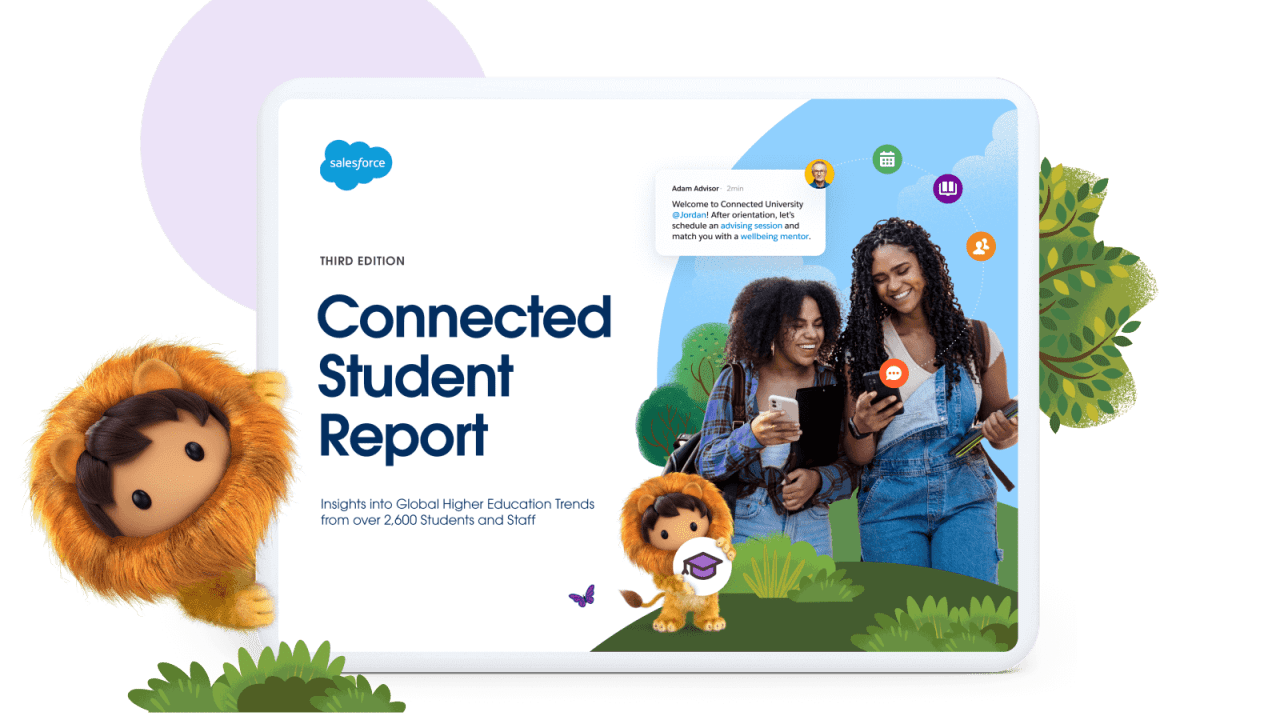Institutions of all sizes measure student success closely, taking into account how well students navigate their higher education experience and progress toward graduation. However, nearly 40% of students don’t complete their degrees, and that percentage is even lower for first-generation students.
Students can face a multitude of challenges during their higher education experience. From wellbeing challenges to academic and financial difficulties, students need holistic support throughout their college or university journey. So what steps can institutions take to proactively drive student success at scale?
Institutions can increase retention rates and staff productivity by capturing a 360-degree view of every student, including their interactions, communication preferences, and more. With this unified view in hand, staff can spend less time gathering data across multiple systems and more time supporting students that need it most. In this article, we’ll unpack how to leverage data in real-time to drive student success, and how institutions can offer students holistic support at pivotal moments throughout their higher education experience.
What drives student success?
Student success is critical to improving an institution’s retention rates. But understanding how to drive retention starts with actionable data, including measuring what’s working well, and what areas need improvement. Most institutions are swimming in data points and may not be able to identify those that should be tracked or which ones help explain the patterns of their student populations.
Student success is multifaceted, with academic performance serving as just one piece of a student’s story. Belonging, connection, wellbeing, financial stability, and meaningful support networks are critical factors as well. It can be helpful to use an established model to identify the critical areas of student success at your institution. One of the most popular models is Tinto’s “Theory of Student Departure” which we’ve turned into the five areas of student success below. The model tracks the student lifecycle in a manner that identifies areas where both student and college characteristics can impact the ongoing decision to stay or leave a college educational program.
Tinto’s model: five areas of student success
Academic integration
Academic integration explores how well a student is prepared for college, how well they’re making the transition into college, and how well they perform each year. Evaluating how well a student integrates academically goes beyond just looking at their term grades. It’s also important to monitor how they’re doing throughout a semester by checking in on whether they’re leveraging academic support resources like tutoring on campus, office hours, or study groups.
Social integration
Social integration includes how students interact with their peers, faculty, and staff. This area of student success examines how students form bonds with their peers through clubs, courses, or similar interests outside of the classroom. It also looks at how often they interact with faculty or staff through advising appointments, office hours, and more. Developing a sense of belonging through social integration is an important factor for student success as it helps build strong support systems for students both on and off campus.
Financial support
Proper financial support can be crucial to student success. Students often consider the financial impact of their education and want to ensure they’re getting a good return on their investment. 40% of students reported needing more financial aid from their university in order to be successful. Students with access to financial aid options and helpful resources explaining the financial aid process, are more likely to stay at an institution through completion.
Goal clarity
Goal clarity examines how students see the culmination of their time in college. It analyzes whether students understand their major and the career opportunities they can pursue with it, which is often challenging given that many students change their major more than once. Goal clarity can be improved when students understand all the requirements for their major, when they gain practical experience in a particular field, or when they have insight into various career options following graduation. Students with clear goals tend to feel less lost and often stay at their institution to see their goals to completion.
Support of family and friends
Having support and understanding from family and friends plays a large part in student success. Families and friends can help ease the burden on college students by supporting them through the application process or difficult coursework. Support from family and friends comes in many different forms and will look different for every student.
First-generation students whose parents didn’t go to college may have a more challenging time getting the support they need because their parents may not understand the complexities of the college experience. This doesn’t mean that their parents are less supportive, as many of them go above and beyond to help their family member during college. They may just not know the amount of time it takes to work on homework outside of classes, or the other potential stressors that come with the college experience.
Support levels vary for each student, and can change or disappear as a student progresses through college. That’s why it’s important for institutions to provide helpful and accessible resources for students throughout their higher education journey.

Article
Top Student Retention Strategies for Higher Education
Improve retention rates with helpful tips focused on elevating the student experience.
Metrics to measure student success
Institutions should look at lagging and leading data points when measuring student success.
Lagging data measures things that have already taken place, such as term GPA, term courses completed, or withdrawing from the university. While measuring lagging data points is essential, it doesn’t allow you to respond in real-time as leading data does.
Leading data indicators allow institutions to respond to student problems as they’re happening. They take into account the complete picture of a student so that it’s easier to understand why they might be struggling. Leading indicators empower institutions to impact persistence in real-time.
For instance, leading data indicators can emerge in advising appointments where students might indicate they’re having trouble connecting with peers or getting the right academic support. Tracking these specific pain points in real-time can enable the institution to intervene in a personalized way and proactively measure student progress over time.
Monitoring data across a student’s experience also helps different parts of the university work together to address concerns. For example, the financial aid office could work with advising when planning a student’s upcoming courses to better accommodate their job schedule. Or faculty can raise timely alerts to advisors when students are struggling in class or need extra time for coursework due to external challenges.
Examples of lagging indicators include:
- High school or transfer GPA
- Percentage of courses completed
- Total number of clubs participated in
- Financial holds
- Cumulative loan levels
- Withdrawal reports
Examples of leading indicators include:
- Performance on assignments, tests, and labs throughout the course
- Course absences
- Engagement with career services or academic advisors
- Transcript requests
- Survey responses gauging support from friends/family
- Unpaid tuition balances
Keeping track of these lagging and leading indicators will help your institution form stronger connections with students and enable you to intervene before a student makes a decision to depart.

Customer Story
“Our goal is really to help each and every student achieve their greatest potential. Part of student success…is creating a sense of belonging that feels connected but also unique to each individual student.”
Miro Humer,
Vice President and Chief Information Officer
Case Western Reserve University
Six strategies to improve student success
Now that we’ve established a framework for driving and measuring student success, let’s dive into some key strategies you can implement at your institution.
1. Communicate with students regularly
Keeping a steady stream of communication with students is essential to maximize student success. Many students would like institutions to communicate with them more through personalized alerts and messages.
The need for increased personalization and up-to-date technology is apparent in student surveys. Only 50% of students feel their university provides a personalized experience that’s tailored to their needs. Meanwhile, 27% of students surveyed thought their university was using outdated technology to support them.
To help satisfy communication and technology needs, set up automated communications with students on the platforms they’re using all day, such as text messages, social media, or email.
Send messages to students informing them of campus-wide events they could attend, institutional news, and reminders to register for classes. You can also send personalized alerts to remind them of upcoming advising appointments, or opportunities specific to their major.
Conversational chatbots are another great way to give students the help they need 24/7. Chatbots are more interactive than just searching the web. Students can use chatbots for frequently asked questions, and institutions can automate helpful responses, which ultimately helps give time back to staff.
In addition to automated chatbots, a live chat with staff members during office hours can assist students who need support from anywhere. Giving students multiple avenues to communicate with your institution will help them feel heard and boost their chances for success.
2. Incorporate holistic advising
Advising plays a pivotal role in student success. To make advising even more effective, incorporate a holistic approach that considers a student’s wellbeing and academic success. Advisors should look at many different pieces of a student’s journey instead of only their academic major or grades. They should also consider their social and financial health and how connected they are to the university community.
Holistic advising, which considers all of the factors that can impact the student experience, can help advisors identify risks or problem areas quickly. For example, knowing that a student is going through a hard time financially could allow for early intervention in the form of offering more flexible courses that allow the student to learn based on their work schedule and needs.
Holistic advising should also include career planning. Only 11% of students say they feel prepared for working life. To help increase this number, incorporate career coaching and pair students with alumni in the same field.
To help streamline the appointment process, offer an appointment scheduling solution that lets students book appointments in real-time with their advisors right from their phone. This will eliminate the need for phone tag or endless email chains, saving students and advisors time. In fact, 77% of students who reported having a great university experience were able to sign up for advising appointments easily compared to 30% of students who had a poor experience according to the Third Edition of the Connected Student Report.
3. Ensure first-generation students are supported
A study from the U.S. Education Department’s National Center for Education Statistics showed one-third of first-generation students dropped out of college after three years. It’s imperative to prioritize initiatives that foster a sense of belonging and help these students thrive throughout their higher education experience.
First-generation students might be commuting to school or juggling work or family care responsibilities on top of course work. To accommodate their schedules, hold extended advising hours or allow quick walk-in advising sessions that will help students understand their degree requirements and provide the flexibility they need.
First-year experience programs can also help first-generation students succeed early in their higher education journey. These often include summer bridge programs, student mentorships, and orientations that help first-generation students adjust to college life. The early days of higher education play an essential role in setting students up for long term success. According to the Third Edition of the Connected Student Report, students with a positive onboarding experience are 35 times more likely to have a great overall university experience. So helping first-generation students adapt and feel comfortable on campus from the very first day of classes can be a critical step forward in driving their success
In addition to tailored programming, it’s important to check in with first-generation students regularly to gauge how they’re doing. Sentiment surveys are a great way to determine how students feel about their higher education experience. Send short polls as well as longer surveys to assess overall wellbeing. Longer surveys can dive deeper into subjects like familial support. Be sure surveys are simple to take, accessible from anywhere, and not too long to drive completion.
4. Help ease the transfer process
Transfer students are another group that can often feel adrift in a university setting after spending two years at community college or moving from another school. Either way, adapting to a new environment and understanding how their credits transfer can be a daunting experience.
In fact, only 14% of community college students obtain a bachelor’s degree within six years of starting a bachelor’s program. If possible, universities should partner with community colleges to create early academic pathways for students. Establishing partnerships with local community colleges can help students planning their transition learn more about your campus and the courses available to them earlier on in the journey,
Another way to ease the burden on transfer students is to make sure all the information they need to know is accessible. A mobile student portal is a great tool to offer transfer students. They can keep track of appointments, see upcoming tasks, and plan in one convenient place.
5. Prioritize mental wellness
Higher education brings with it feelings of stress and anxiety for many students. Institutions must emphasize mental health and emotional wellbeing to promote student success, but only 21% of students surveyed for the Third Edition of the Connected Student Report feel their institution is doing so.
Create a campus culture that encourages student, faculty, and staff wellbeing. Focus on promoting self-care activities like exercise, meditation, and taking time for oneself. Online campus communities support wellbeing by providing a space for students to engage with each other, faculty, and staff virtually. Students can talk through their worries, make friends, and establish study groups from their computer.
It’s also important to build a work environment where faculty and staff can support one another. When an institution’s employees are doing well, it will create a healthier student environment. Be sure to equip faculty with the resources to detect wellbeing issues. One way to do this is to keep student data in a central hub. This way, it will be easier to spot student problems and make referrals faster.
Wellbeing starts even before students step on campus with resources that are shared during the enrollment process through graduation. Throughout the entire higher education journey, institutions should ensure students continue to know about the mental health resources available to them.

Guide
Rethinking Wellbeing in Higher Education
Transforming the student experience means making wellbeing a top priority. Discover best practices on giving the support your students need throughout their education journey.
6. Offer opportunities for connection and belonging
Higher education students can often feel overworked and isolated. Feeling connected on campus is important. In fact, 46% of students who feel connected described their university experience as being great.
31% of students consider social life and campus activity an important factor when choosing a university. To increase student success, give students a variety of opportunities for connection with their peers both on and off campus
To boost student connection, facilitate informational events every semester that show students what activities and clubs are available on campus. Notify students of upcoming campus activities through an updated calendar and messaging alerts. Make sure students know about clubs and organizations that align with their majors and interests.
Set up buddy-systems that pair upperclassmen with newer students. This will help new students learn the ropes of the university and increase their sense of belonging. Additionally, offer plenty of chances for students to connect with alumni in their field.

Report
Connected Student Report, Third Edition
Uncover new opportunities to drive student success and improve retention.
Remember that student success is multi-layered and shaped by more than just academics. It starts with taking the time to understand the whole student, and offering holistic support — from financial aid access to wellbeing resources — throughout their entire college experience.
Using models like Tinto’s five areas of student success can help identify areas where both student and college characteristics can impact the decision to stay in or leave a higher education program. Additionally, creating a framework for both lagging and leading data indicators can arm your institution with the data needed to drive student persistence at the right time for maximum impact.
Having a strong technology foundation will do wonders for measuring and understanding this data in real-time. The right student success software will help manage and track a student’s entire higher education journey in one central place, while making it easy to take action on insight. With a single view, institutions can spend less time gathering data across multiple siloed systems and more time ensuring students have the tools they need to succeed from day one.
Unlock the Student Experience Demo
Increase staff productivity and deliver holistic student success at scale with an integrated CRM platform tailored to your institution’s needs.
